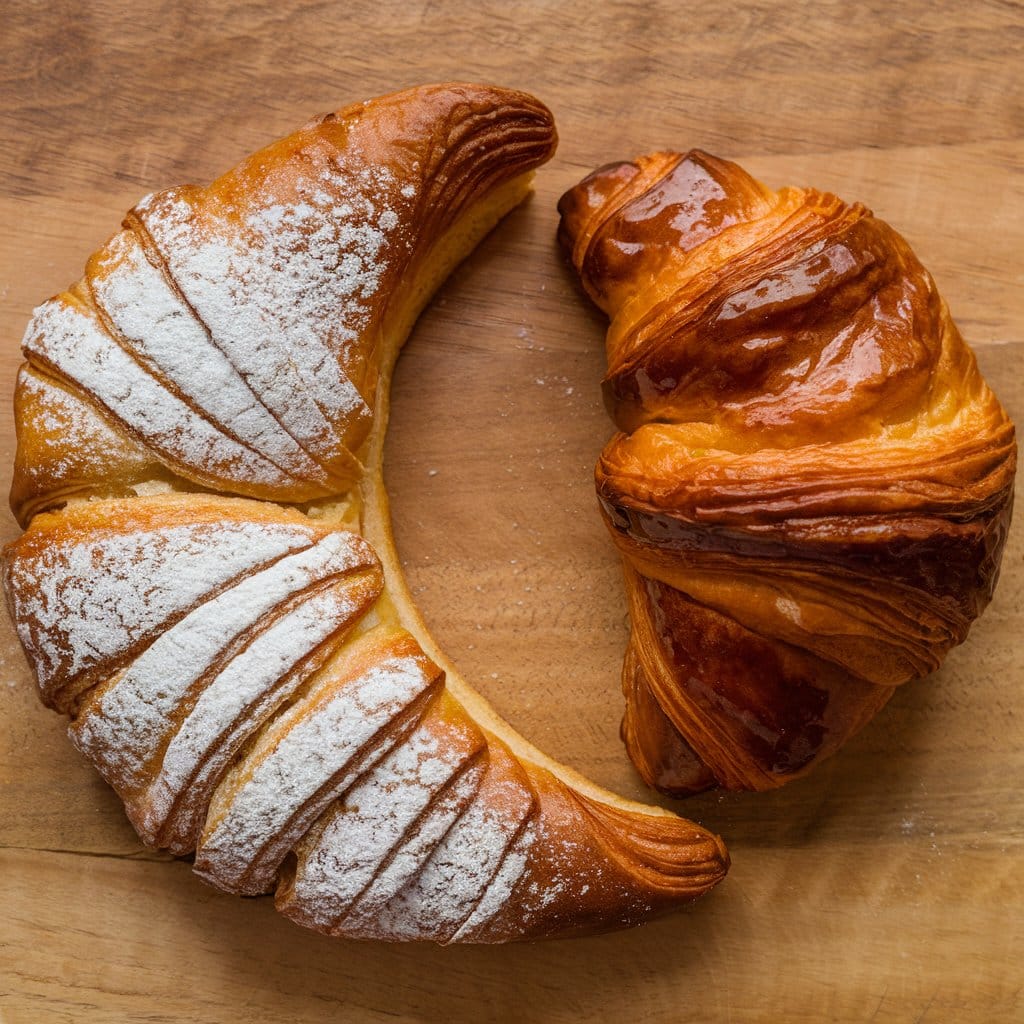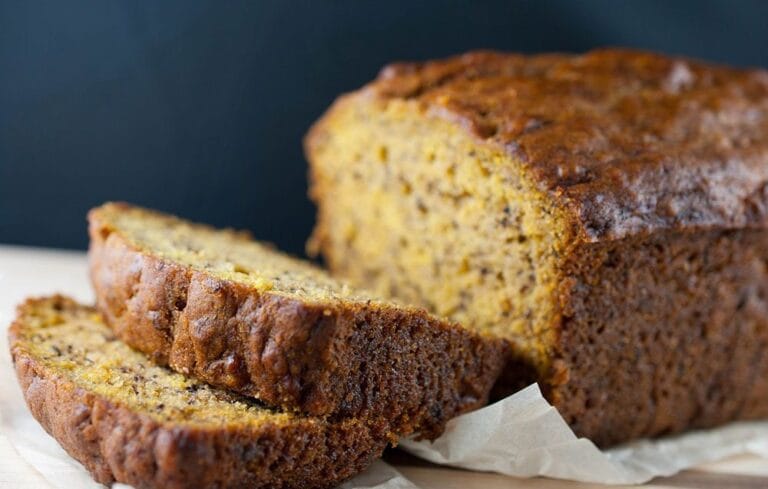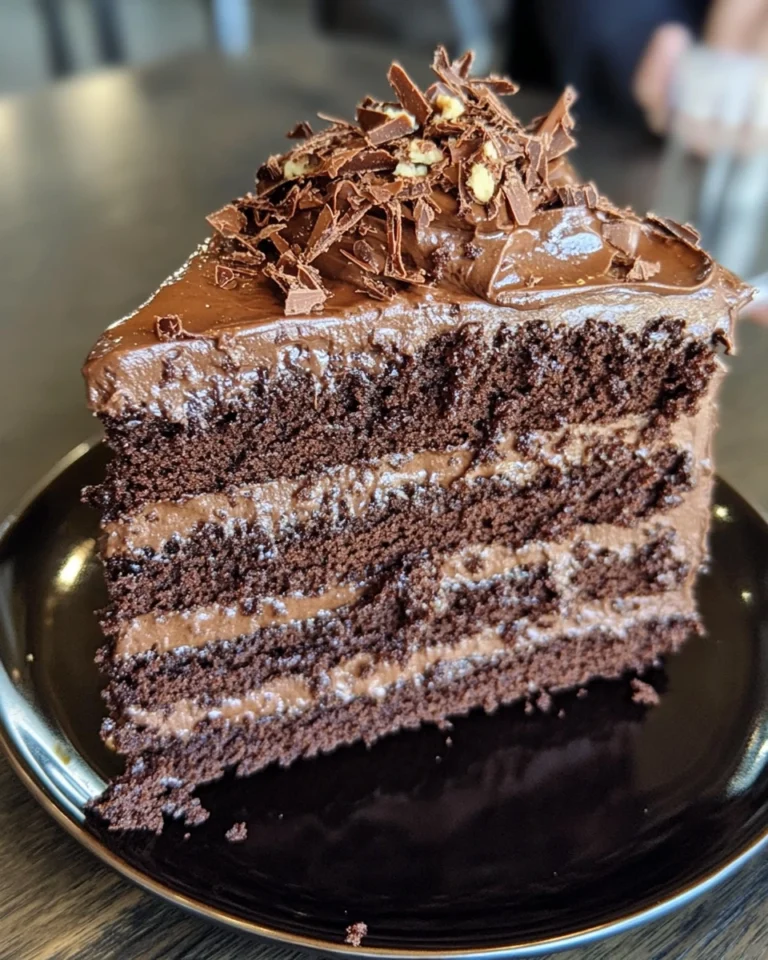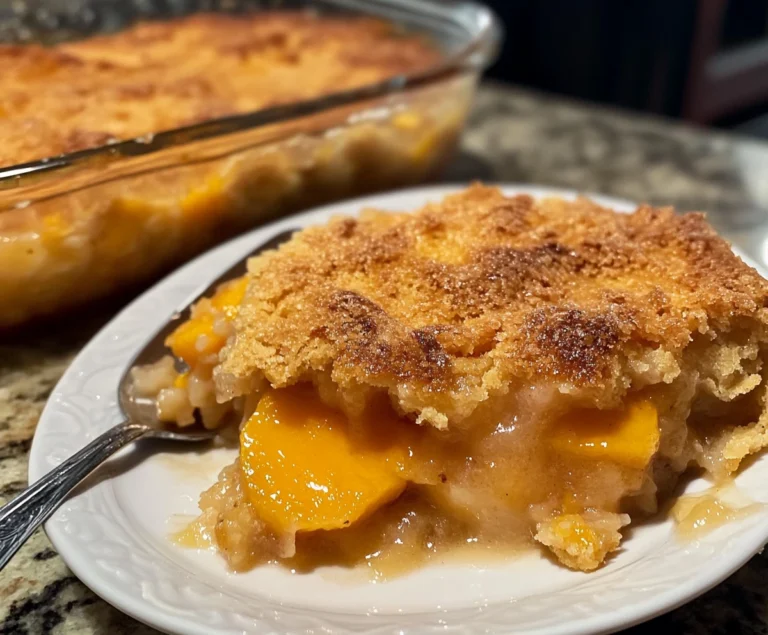What is the difference between a croissant and a gipfeli?
Pastries are beloved worldwide for their variety and deliciousness. Among the most popular are the croissant and the gipfeli. Both pastries are crescent-shaped and flaky, yet they offer distinct characteristics that reflect their cultural origins and unique preparation methods. This guide will explore the differences between these two pastries, covering their history, ingredients, preparation techniques, taste, texture, and more. By the end, you’ll understand these treats better and be able to choose the right one for your next indulgence.
Origins and History
The history of a pastry provides insight into its cultural significance and how it evolved into its current form.
Croissant: A French Icon with Austrian Roots
The croissant, a symbol of French cuisine, has origins in Austria. Its predecessor, the kipferl, dates back to at least the 13th century. The kipferl was a simple, crescent-shaped bread that could be sweet or savory, often filled with nuts or other ingredients.
The croissant came to France in the late 17th century, brought by Austrian bakers. However, it wasn’t until the early 19th century that it began to transform into the buttery, flaky pastry we know today. French bakers introduced laminated dough, which involves folding butter into dough multiple times to create thin layers. This process results in the light, airy texture that defines the modern croissant.
By the 20th century, the croissant was a staple in French patisseries and a symbol of French culture. Its popularity spread worldwide, making it a common sight in cafes from New York to Tokyo. To learn more about the history of croissants, you can explore how it traveled from Austria to France.
Gipfeli: A Swiss Staple with Deep Cultural Roots
The gipfeli, also known as kipferl in some regions, is a traditional Swiss pastry with roots in Central Europe. Unlike the croissant, which evolved significantly in France, the gipfeli has stayed close to its origins. The name “Gipfeli” comes from the German word “Gipfel,” meaning “peak,” which describes its crescent shape.
The gipfeli has been part of Swiss cuisine for centuries, often enjoyed as a breakfast item or snack. It is made with a yeast-based dough enriched with butter or margarine, giving it a slightly denser texture than a croissant. It also comes with various fillings, from sweet options like chocolate or jam to savory choices like ham and cheese. This versatility makes it a favorite in Swiss homes and bakeries. If you want to try making this Swiss treat, follow a Gipfeli recipe.
While the croissant is a global favorite, the gipfeli remains a regional specialty in Switzerland, Austria, and Germany. Its ongoing popularity in these areas reflects its deep cultural roots and the qualities that set it apart from its more famous French cousin. For more on Swiss pastries, see Swiss pastries explained.
Ingredients and Preparation
The ingredients and preparation techniques for croissants and gipfeli are key to their unique textures and flavors. Understanding these differences highlights what makes each pastry special.
Croissant: The Art of Lamination
A croissant’s defining feature is its flaky texture, achieved through a process called lamination. This technique layers butter between sheets of dough, which are then folded and rolled out several times. Each fold creates more layers of dough and butter, which puff up and separate during baking, resulting in the light, airy texture of croissants.
Key Ingredients
- Flour: Strong bread flour provides the structure needed to support the butter layers.
- Butter: High-quality butter is essential. It must be cold and pliable to endure the folding process.
- Yeast: Active dry or fresh yeast helps the dough rise, giving it a fluffy interior.
- Sugar and Salt: These enhance the dough’s flavor.
- Milk or Water: Used to hydrate the dough, giving it the right consistency for rolling and folding.
Preparation Process
- Dough Preparation: The dough is mixed, kneaded, and left to rise until it doubles in size.
- Lamination: The dough is rolled out, and a block of butter is placed in the center. The dough is folded over the butter and rolled out again. This is repeated several times to create layers.
- Shaping: The laminated dough is cut into triangles and rolled into crescent shapes.
- Proofing: The shaped croissants proof until doubled in size.
- Baking: They are baked at high temperatures, resulting in a crisp, golden-brown exterior and a soft, airy interior.
The lamination process requires patience and precision. The dough must stay cold to prevent the butter from melting and ruining the layers. Mastering this technique is considered a high art in baking. For more on lamination, see how to make laminated dough.
Gipfeli: Simple and Versatile
The gipfeli is made from a yeast-based dough that is rolled and shaped into a crescent. Unlike the croissant, its dough is not laminated. Instead, it is enriched with butter or margarine and can be filled with various ingredients, like sweet jams, chocolate, or savory items like ham and cheese. This gives the gipfeli a denser texture compared to the croissant, offering a different flavor profile.
Key Ingredients
- Flour: All-purpose or pastry flour is often used to create a more tender crumb.
- Yeast: Essential for leavening the dough, providing a slight rise and a subtle yeast flavor.
- Butter or Margarine: Enriches the dough, contributing to a softer, more tender texture.
- Sugar and Salt: Added to enhance flavor.
- Fillings: A variety of fillings can be used, from sweet (e.g., chocolate, jam) to savory (e.g., cheese, ham).
Preparation Process
- Dough Preparation: The dough is mixed, kneaded, and allowed to rise until it doubles in size.
- Shaping: The dough is rolled out and cut into triangles, which are rolled into crescent shapes.
- Proofing: The shaped gipfeli proof until doubled in size.
- Baking: Baked until golden brown and cooked through.
Preparing gipfeli is more straightforward and forgiving than croissants, making it more accessible for home bakers. The absence of lamination makes the dough easier to handle, and the variety of fillings allows for creativity. For those wanting to experiment with different flavors, gipfeli offers a flexible canvas. Check out the bread flour recipes to explore how different flours can be used in baking.
Taste and Texture
Croissants and gipfeli differ greatly in taste and texture, despite their similar crescent shape and golden exterior.
Croissant: Light, Flaky, and Buttery
The croissant is famous for its buttery, flaky texture. Its exterior is golden brown and crispy, while the interior is soft and airy. Each bite starts with a satisfying crunch and finishes with a delicate, melt-in-your-mouth feel. The flavor is rich and subtly sweet, with buttery layers that add depth and indulgence.
This lightness is achieved through lamination, which creates thin, separate layers of dough and butter. As the croissant bakes, the water in the butter turns to steam, causing the layers to puff up and create its characteristic flaky texture. This makes the croissant a favorite for those who appreciate the art of fine baking.
Gipfeli: Dense, Flavorful, and Versatile
The gipfeli also features a flaky texture but tends to be denser due to its dough composition. It has a more compact texture, with a soft yet substantial crumb. The gipfeli’s flavor is more pronounced, thanks to the yeast and the variety of fillings. Fillings like chocolate, jam, cheese, or ham add extra layers of flavor, making each bite unique.
The gipfeli’s denser texture and robust flavor profile appeal to those who prefer a heartier pastry. Its versatility in fillings also makes it adaptable to different tastes and occasions.
Shape and Size
Both croissants and gipfeli are crescent-shaped, but their size and shape reflect their unique preparation methods and cultural roots.
Croissant: Elegant and Iconic
Croissants are typically crescent-shaped with pointed tips. They range in size, from small, bite-sized versions to larger, more substantial pastries perfect for a hearty breakfast or snack. The shape is elegant and distinctive, often linked to the sophistication of French patisseries. The pointed tips and curved shape result from how the dough is rolled and shaped before baking.
This shape isn’t just for aesthetics; it also affects texture. The outer layers become crisp and flaky during baking, while the inner layers stay soft and tender. This contrast in textures enhances the eating experience and makes the croissant visually appealing.
Gipfeli: Rustic and Charming
Gipfeli also have a crescent shape but are usually smaller than croissants. They have a more pronounced curve and often feature a slight bulge in the center, giving them a distinctive, rustic look. This shape reflects the homey, comforting appeal of Central European bakeries.
The gipfeli’s smaller size makes it a convenient snack or breakfast item, easy to enjoy on the go. Its compact shape also allows for a wider variety of fillings, making it a versatile option for experimenting with flavors and textures.
Popularity and Availability
The popularity and availability of croissants and gipfeli vary widely, reflecting their cultural origins and the regions where they are most enjoyed.
Croissant: A Global Icon
The croissant is a worldwide culinary icon, available in cafes, bakeries, and supermarkets everywhere. Its popularity extends beyond France, making it a staple breakfast item in many countries. Croissants are enjoyed plain or with fillings like almond paste, chocolate, or ham and cheese, adding to their versatility.
In many places, the croissant is synonymous with breakfast, often paired with coffee or tea. Its global appeal comes from its delicate flavor, flaky texture, and sense of indulgence. The croissant’s adaptability to different tastes and preferences, whether sweet or savory, further enhances its universal popularity.
Gipfeli: A Regional Favorite
The gipfeli is mainly popular in Central Europe, especially in Switzerland, Austria, and Germany. It is a common breakfast choice or afternoon snack in these regions, typically found in local bakeries. Outside Central Europe, gipfeli may be less known, but they’re gaining recognition for their unique taste and texture.
In Switzerland, the gipfeli is a beloved part of local cuisine, often enjoyed with coffee or tea in the morning. It’s also a popular choice for a quick, satisfying snack. While it hasn’t achieved the same global fame as the croissant, its continued regional popularity speaks to its unique qualities and cultural importance.
Nutritional Differences
While both croissants and gipfeli are delicious, they have different nutritional profiles. Understanding these differences helps make informed choices based on dietary needs and preferences.
Croissant: Rich and Calorically Dense
Due to its high butter content and use of refined flour, the croissant is relatively high in calories and fat. A standard butter croissant can contain 250 to 350 calories, with much of this from fat. The croissant’s rich, buttery flavor comes from this high fat content, which also gives it its flaky texture.
Croissants are low in protein and fiber, making them less filling than more substantial breakfast options. However, fillings like ham and cheese can boost the protein content, making them a more balanced meal option.
Gipfeli: Versatile and Potentially Healthier
The gipfeli, depending on its preparation and fillings, can be a lighter option than the croissant. Its dough is often less rich in butter, reducing overall fat and calorie content. However, various fillings can alter its nutritional profile. For example, a jam-filled gipfeli will be higher in sugar, while a savory gipfeli with ham and cheese will have more protein and potentially more fat.
The gipfeli’s versatility allows for a range of nutritional options. A gipfeli made with whole grain flour and filled with fruit or nuts can provide more fiber and nutrients, making it a more balanced choice.
Choosing Between Croissant and Gipfeli
Choosing between a croissant and a gipfeli depends on personal preferences and dietary considerations. Here are some factors to consider:
- Flavor and Texture: If you prefer a flaky, buttery pastry with a delicate flavor, the croissant is a great choice. For those who like a denser, more robust pastry with various fillings, the gipfeli is a delightful option.
- Nutritional Content: If you’re looking for a lighter option, a gipfeli with whole grain flour and a healthy filling might be better. However, if indulging in a treat, a rich, buttery croissant can be a satisfying choice.
- Cultural Experience: Both pastries offer a unique cultural experience. Enjoying a croissant can feel like visiting a French cafe, while savoring a gipfeli can provide a taste of Swiss tradition.
Each pastry reflects the culinary traditions of its culture, providing a unique taste experience. Whether you want a delicate, flaky treat or a hearty, flavorful pastry, both the croissant and the gipfeli have something special to offer.
FAQs
To further clarify the differences between these two pastries, here are some frequently asked questions:
What is the difference between a croissant and a gipfeli?
A croissant is made with laminated dough, resulting in a flaky texture, while a gipfeli is made with yeast-based dough that is rolled and shaped. Croissants are typically larger and have pointed tips, while gipfeli are smaller with a more pronounced curve.
Which pastry has a more pronounced flavor?
The gipfeli usually has a more pronounced flavor than the croissant, due to its denser dough and various fillings. The croissant, with its buttery layers, offers a more delicate and refined flavor profile.
Which pastry is more popular?
The croissant is more popular globally, while the gipfeli is primarily enjoyed in Central Europe. The croissant’s widespread appeal is due to its delicate flavor and flaky texture, while the gipfeli’s popularity is rooted in its cultural significance and versatility.
Are there any nutritional differences?
A croissant may contain more fat and calories due to its butter-rich laminated dough. In contrast, a gipfeli, which is denser, can vary widely depending on its fillings. A gipfeli made with whole grain flour and healthier fillings can be a lighter option.
Can gipfeli be considered a variation of croissants?
Though both pastries share a crescent shape, the gipfeli is not a variation of the croissant. They have different origins, preparation methods, and flavor profiles, making them distinct. The croissant’s laminated dough sets it apart, while the gipfeli’s yeast-based dough and variety of fillings give it a unique character.
What are some common fillings for gipfeli?
Gipfeli can be filled with a wide range of ingredients, both sweet and savory. Common sweet fillings include chocolate, jam, and almond paste, while savory options might include ham, cheese, or herbs.
Conclusion
Both the croissant and the gipfeli are exceptional pastries that offer unique and memorable culinary experiences. Whether you prefer the classic elegance of the croissant or the rustic charm of the gipfeli, these pastries will surely satisfy your cravings, whether sweet or savory. Try both to fully appreciate their qualities and find your favorite!
By understanding the differences between these two beloved pastries, you can make an informed choice the next time you’re in a bakery, ensuring a delicious experience that suits your taste. Whether enjoying a leisurely breakfast in a French cafe or grabbing a quick snack from a Swiss bakery, both the croissant and the gipfeli offer a taste of their rich culinary heritage.







